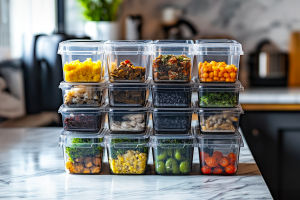Have you ever wondered why some people seem to get more energy and feel better on a plant-based diet, while others struggle with fatigue or digestion?
A key factor often overlooked is how the foods we eat work together to affect nutrient absorption. For vegans and vegetarians, knowing how to combine ingredients properly can make a huge difference in maximizing the benefits of a plant-based diet.
Let's take a closer look at how pairing certain foods—like legumes with whole grains—can improve nutrient uptake, and how simple tweaks to your meals can help you get the most from every bite.
The Protein Puzzle: Complementing Plant Proteins
One common question from vegans is how to get enough complete protein, since many plant proteins are "incomplete" — meaning they lack one or more essential amino acids.
Here's where food pairing plays a crucial role. Combining legumes (beans, lentils, chickpeas) with whole grains (brown rice, quinoa, oats) provides all nine essential amino acids your body needs to build and repair tissues.
Why does this work?
• Legumes are typically low in the amino acid methionine but high in lysine.
• Grains are low in lysine but rich in methionine.
When eaten together, these foods complement each other, creating a complete protein profile equivalent to animal sources.
For example, a classic dish of rice and beans isn't just tasty — it's nutritionally powerful. You don't have to eat them in the same meal, either; as long as you consume a variety of complementary proteins throughout the day, your body can pool the amino acids for use.
Enhancing Mineral Absorption: Iron and Zinc
Plant-based diets can provide plenty of iron and zinc, but these minerals are often in a form called non-heme iron, which is less easily absorbed than the heme iron found in animal products. Luckily, pairing foods correctly can boost absorption significantly.
Pairing vitamin C with iron-rich foods
Vitamin C is a superstar for improving iron uptake. For instance, adding bell peppers, citrus fruits, or strawberries to meals with beans, lentils, or spinach can double or even triple the amount of iron your body absorbs.
Similarly, soaking, sprouting, or fermenting beans and grains helps reduce phytates—compounds that inhibit zinc absorption—making zinc more bioavailable.
A practical meal example: a lentil salad tossed with fresh lemon juice, cherry tomatoes, and parsley not only tastes vibrant but also maximizes your iron intake.
Lipid Matters: Unlocking Lipid-Soluble Vitamins
Certain vitamins, such as A, D, E, and K, need dietary lipids to be absorbed properly. Since many vegan meals are naturally low in lipids, it's important to include healthy lipids sources.
Adding a small amount of avocado, nuts, seeds, or olive oil to meals can significantly improve the absorption of these vitamins from colorful vegetables. For example, a spinach salad dressed with olive oil or a smoothie with flaxseeds ensures your body makes the most of the nutrients in those foods.
Timing and Food Preparation: Little Details Make a Big Difference
Beyond combining the right foods, how you prepare and time your meals can influence nutrient uptake.
• Cooking tomatoes increases lycopene availability, a powerful antioxidant.
• Soaking beans reduces cooking time and anti-nutrients, aiding digestion and mineral absorption.
• Avoiding tea or coffee with meals can prevent tannins from inhibiting iron absorption; instead, enjoy these beverages between meals.
These small habits add up to better digestion and nutrient use over time.
Expert Insight: Why It All Matters
Nutrition experts like Dr. Michael Greger highlight that plant-based diets have incredible health benefits, but proper food pairing is essential to avoid common deficiencies and feel your best. Registered dietitians also emphasize diversity and balance — the more colorful and varied your diet, the better your nutrient coverage.
According to Dr. Mark Hyman, "The strategy of combining legumes and grains to form a complete protein profile is a foundational principle in plant-based nutrition. Additionally, the role of vitamin C in significantly enhancing the absorption of non-heme iron from plant sources is a well-documented and critical interaction for preventing deficiencies and promoting optimal metabolic function."
Next time you plan your meals, think about how the ingredients work together, not just individually. What simple changes could you make to boost your nutrient intake? Maybe add some lemon to your bean dish or toss nuts into your salad? Small tweaks like these can transform your vegan meals from just "good" to truly nourishing.
What's your favorite food combo that you think everyone should try? I'd love to hear your ideas!


